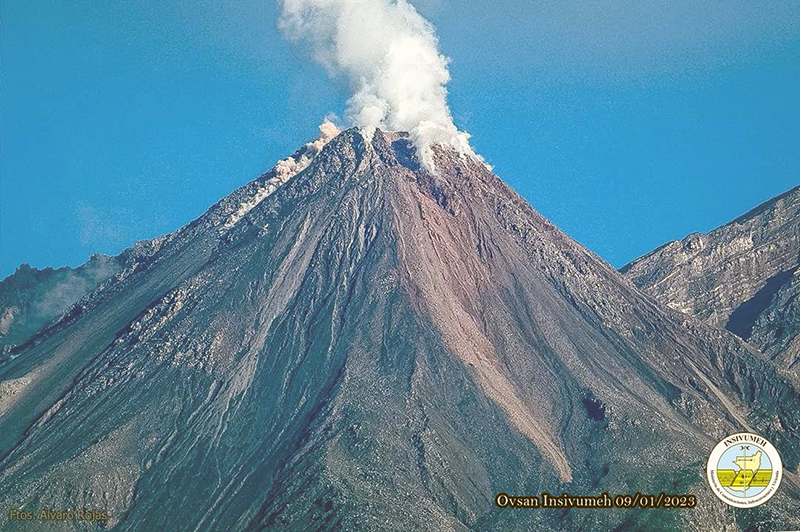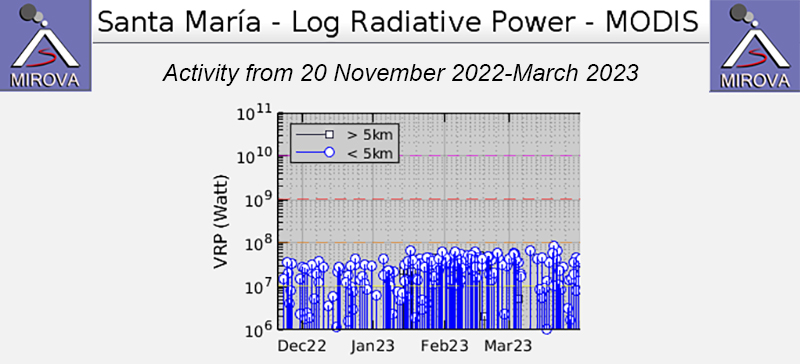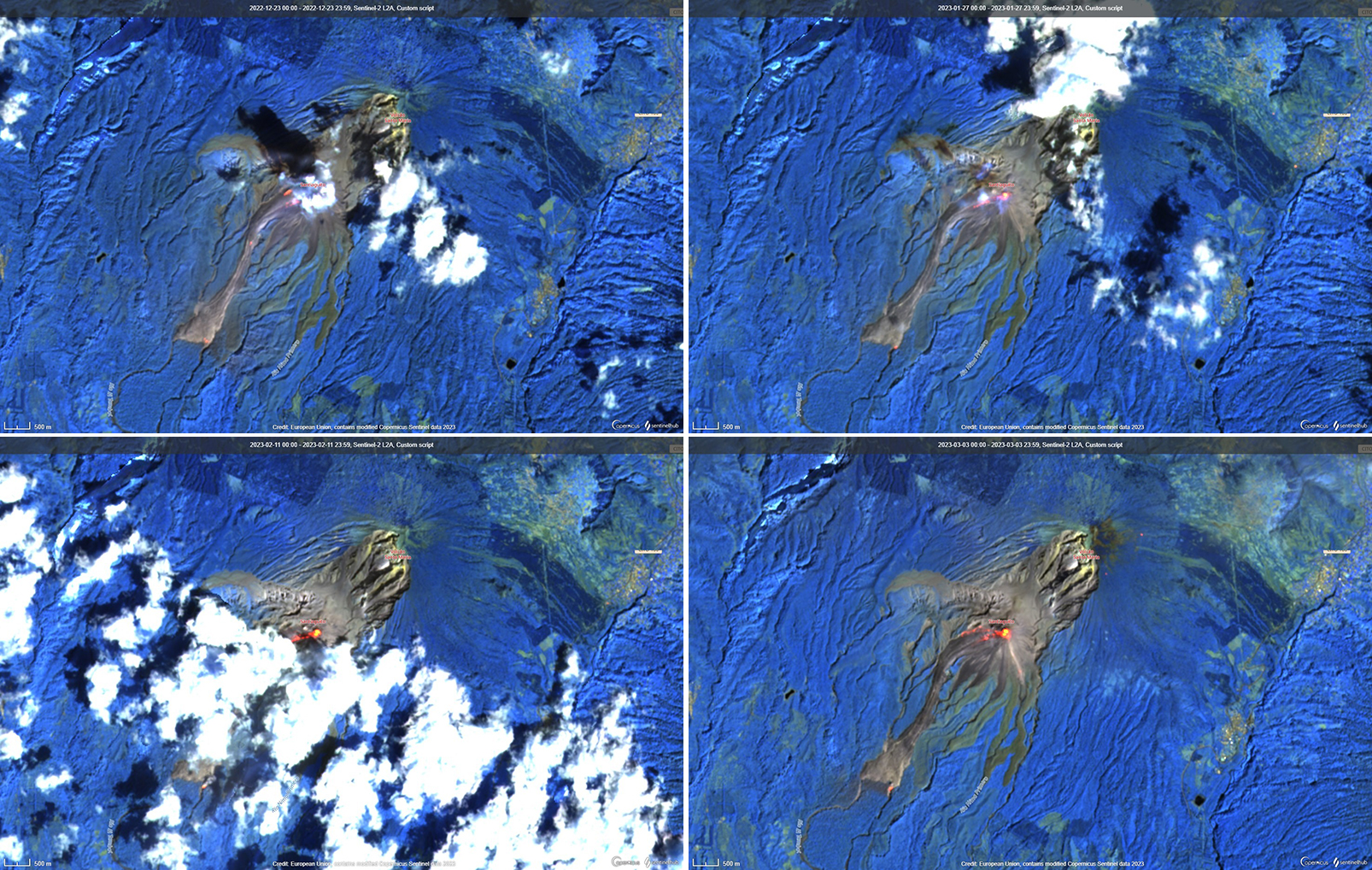Report on Santa Maria (Guatemala) — April 2023
Bulletin of the Global Volcanism Network, vol. 48, no. 4 (April 2023)
Managing Editor: Edward Venzke.
Edited by Kadie L. Bennis.
Santa Maria (Guatemala) Active lava flows, explosions, ash plumes, and ashfall during December 2022-March 2023
Please cite this report as:
Global Volcanism Program, 2023. Report on Santa Maria (Guatemala) (Bennis, K.L., and Venzke, E., eds.). Bulletin of the Global Volcanism Network, 48:4. Smithsonian Institution.
Santa Maria
Guatemala
14.757°N, 91.552°W; summit elev. 3745 m
All times are local (unless otherwise noted)
The Santiaguito lava-dome complex of Guatemala's Santa María volcano has been actively erupting since 1922. The lava dome-complex formed within a large crater on the SW flank of Santa Maria that formed during the 1902 eruption. Ash explosions, pyroclastic flows, and lava flows have emerged from Caliente, the youngest of the four vents in the complex, for more than 40 years. The Caliente vent has an elevation of about 2.5 km, and the summit of Santa Maria is at about 3.7 km elevation. A lava dome that appeared within the summit crater of Caliente in October 2016 has continued to grow, producing frequent block avalanches down the flanks. Recent activity has included frequent explosions, ash plumes, and ashfall (BGVN 48:03) has persisted for this reporting period of December 2022 through March 2023, using information from Guatemala's INSIVUMEH (Instituto Nacional de Sismologia, Vulcanologia, Meterologia e Hidrologia) and satellite data.
Activity during December 2022 consisted of weak-to-moderate explosions and white-to-gray and blue gas-and-steam emissions that rose 200-800 m above the crater and drifted up to 15 km SW, NW, S, W, SSW, E, SE, and N. Explosions generated ash plumes that drifted as far as 6 km W and SW. Nighttime crater incandescence was often visible above the Caliente dome, accompanied by active lava flows that mainly traveled down the W, SW, and WSW flanks each day during December, also affecting the San Isidro (W) and El Tambor (SW) drainages. Frequent block-and-ash avalanches were detected on the W, WSW, S, and SE flanks, which sometimes resulted in ash plumes that drifted up to 10 km downwind. Ashfall was reported in Finca la Mosqueta and Santa Marta (5-6 km SW) on 2 December and in Las Marías (10 km S), Viejo Palmar, and the Palajunoj area on 9 December. On 11 December the active lava flow in the San Isidro and El Tambor drainages generated some block collapses, which resulted in ash clouds that rose several hundred meters high and drifted toward the Zanjón Seco drainage (SW flank). On 13, 18, 27, and 31 December block collapses from the lava flow generated ash clouds that rose several hundred meters high and drifted toward the San Isidro drainage. The smell of sulfur was reported on 13 December to the SE of the Caliente dome and on 14 December in the Las Marías area. Ashfall was recorded in Lotación Las Marías, Santa Marta, La Florida (6 km S), and El Faro (7 km S) on 22 December, which was accompanied by the smell of sulfur. Explosions on 27 and 31 December resulted in weak ashfall in El Faro, La Florida, Santa Marta, El Viejo (11 km S), El Palmar (12 km SSW), and Lotación Las Marías.
Daily white-to-gray gas-and-steam emissions continued during January 2023, rising 300-900 m above the crater, and drifting 3.5-8 km SW, W, S, SE, and E. Weak-to-moderate explosions persisted throughout the month, generating ash plumes that rose up to 900 m and drifted E, NE, and SW. Crater incandescence in the Caliente dome, on the S flank, and at the front of the lava flow on the W and SW flanks was visible. Lava flows were often observed on the W, SW, and WSW flanks in the San Isidro and El Tambor drainages; on 19 and 23 January the active lava flow was noted in the Zanjón Seco and San Isidro drainages and the longest part of the lava flow was 4.4 km on 15 January. Weak-to-moderate block collapses and block-and-ash avalanches were recorded at the middle and front of the lava flow on the W, SW, and WSW flanks of the Caliente dome, and on the S and SE flanks, which sometimes caused ash to rise as high as 1 km altitude and disperse 3 km to the W and S (figure 135). On 7 January explosions generated ash plumes that rose to 3 km altitude and drifted SW. On 9 January ashfall was recorded over Las Marías and El Viejo Palmar. The active lava flow in the San Isidro and El Tambor drainages generated some block collapses on 11 January, which produced ash plumes that rose several hundred meters high and caused weak ashfall in El Faro, La Florida, Santa Marta, El Viejo Palmar, and Las Marías. Ashfall was recorded at Monte Carlo on 13 January, weak ashfall was reported in El Faro, La Florida, Santa Marta, El Viejo Palmar, and Las Marías on 19 January, and weak ashfall was again reported on 23 January in Monte Claro, El Faro, La Florida, Santa Marta, and El Viejo Palmar.
Similar activity persisted during February with frequent explosions that produced white gas-and-steam and ash emissions that rose 200-700 m above the crater and drifted SW, W, SE, E, and NW. During the night and early morning, constant crater incandescence at Caliente dome was observed, in addition to incandescence from the active lava flow on the W, SW, and WSW flanks. Weak-and-moderate avalanches were visible on the S, SW, W, SE, WSW, and E flanks and in the middle and front of the lava flow, sometimes generating ash clouds that rose several hundred meters high. Explosions on 3 February expelled gas-and-ash plumes that rose to 3.2 km altitude and drifted W. On 4 February explosions were accompanied by audible rumbles heard in El Palmar; gas-and-ash plumes rose several hundred meters above the lava dome and incandescent avalanches traveled W, S, and SE on the flanks. That same day, the lava flow was reported in the Zanjón Seco and San Isidro drainages; block collapses generated ash clouds that rose several hundred meters high. Weak ashfall was reported in Monte Claro, El Faro, La Florida, Santa Marta, and El Viejo Palmar. Seismic stations registered weak-to-moderate explosions that produced gray plumes that rose to 3.3 km altitude on 8, 11, and 19 February, which generally drifted W and SW. On 9 February ash plumes that rose 800 m above the crater and extended E. Explosions and block collapses on 12 February caused ashfall in Monte Claro, El Faro, La Florida, Santa Marta, and El Viejo Palmar. During the early morning of 15 February, four explosions were detected that generated gray plumes that rose to 2.9 km altitude. Nine explosions were recorded on 16 February, which produced gray plumes and generated weak avalanches on all flanks. On 20 February weak ashfalls from explosions and block collapses were reported in Monte Claro, El Faro, La Florida, Santa Marta, and El Viejo Palmar. Measurements taken on 23 February showed that the length of the lava flow was 4.3 km long.
During March, degassing 400-800 m above the crater dispersed W, SW, S, and SE, and nighttime crater and lava flow incandescence to the WSW continued. Weak-to-moderate avalanches were reported on the S, W, SE, E, and N flanks and from the middle and front of the lava flow. The lava flow remained active on the SW, W, and WSW flanks and in the Zanjón Seco and San Isidro drainages, occasionally accompanied by block collapses that generated ash clouds up to several hundreds of meters high. Weak-to-moderate explosions persisted throughout the month, producing gas-and-ash emissions rising 500-1,000 m above the crater and drifting SW. On 19 March a gas-and-ash plume rose to 3.2 km altitude and drifted S and SE; the lava flow remained at 4.3 km long on the SW flank, according to INSIVUMEH. Additionally, strong rains in the upper part of the volcanic complex caused a lahar to descend the Cabello de Ángel drainage on the SE flank, consisting of a cement-like mixture of volcanic material and transporting tree branches of varying sizes. Small pyroclastic flows were reported during 22-23 March. Explosions on 23 March generated an ash plume that rose to 3.5 km altitude and drifted W and on 24 March ash plumes rose to 4.3 km altitude and drifted W. On 31 March explosions produced ash plumes that rose to 3.5 km altitude and drifted W, accompanied by constant avalanches on the S, SW, E, and N flanks of the Caliente dome and small pyroclastic flows.
The MIROVA (Middle InfraRed Observation of Volcanic Activity) graph showed moderate-power thermal anomalies during the reporting period; the intensity gradually increased over January through March, and the frequency remained relatively high (figure 136). A total of 75 MODVOLC thermal alerts were issued on 40 days during December-March. Incandescent avalanches and active lava flows were also occasionally visible over the Caliente dome in Sentinel-2 infrared satellite imagery on clear weather days (figure 137).
Geological Summary. Symmetrical, forest-covered Santa María volcano is part of a chain of large stratovolcanoes that rise above the Pacific coastal plain of Guatemala. The sharp-topped, conical profile is cut on the SW flank by a 1.5-km-wide crater. The oval-shaped crater extends from just below the summit to the lower flank, and was formed during a catastrophic eruption in 1902. The renowned Plinian eruption of 1902 that devastated much of SW Guatemala followed a long repose period after construction of the large basaltic andesite stratovolcano. The massive dacitic Santiaguito lava-dome complex has been growing at the base of the 1902 crater since 1922. Compound dome growth at Santiaguito has occurred episodically from four vents, with activity progressing E towards the most recent, Caliente. Dome growth has been accompanied by almost continuous minor explosions, with periodic lava extrusion, larger explosions, pyroclastic flows, and lahars.
Information Contacts: Instituto Nacional de Sismologia, Vulcanologia, Meteorologia e Hydrologia (INSIVUMEH), Unit of Volcanology, Geologic Department of Investigation and Services, 7a Av. 14-57, Zona 13, Guatemala City, Guatemala (URL: http://www.insivumeh.gob.gt/); MIROVA (Middle InfraRed Observation of Volcanic Activity), a collaborative project between the Universities of Turin and Florence (Italy) supported by the Centre for Volcanic Risk of the Italian Civil Protection Department (URL: http://www.mirovaweb.it/); Hawai'i Institute of Geophysics and Planetology (HIGP) - MODVOLC Thermal Alerts System, School of Ocean and Earth Science and Technology (SOEST), Univ. of Hawai'i, 2525 Correa Road, Honolulu, HI 96822, USA (URL: http://modis.higp.hawaii.edu/); Copernicus Browser, Copernicus Data Space Ecosystem, European Space Agency (URL: https://dataspace.copernicus.eu/browser/).




